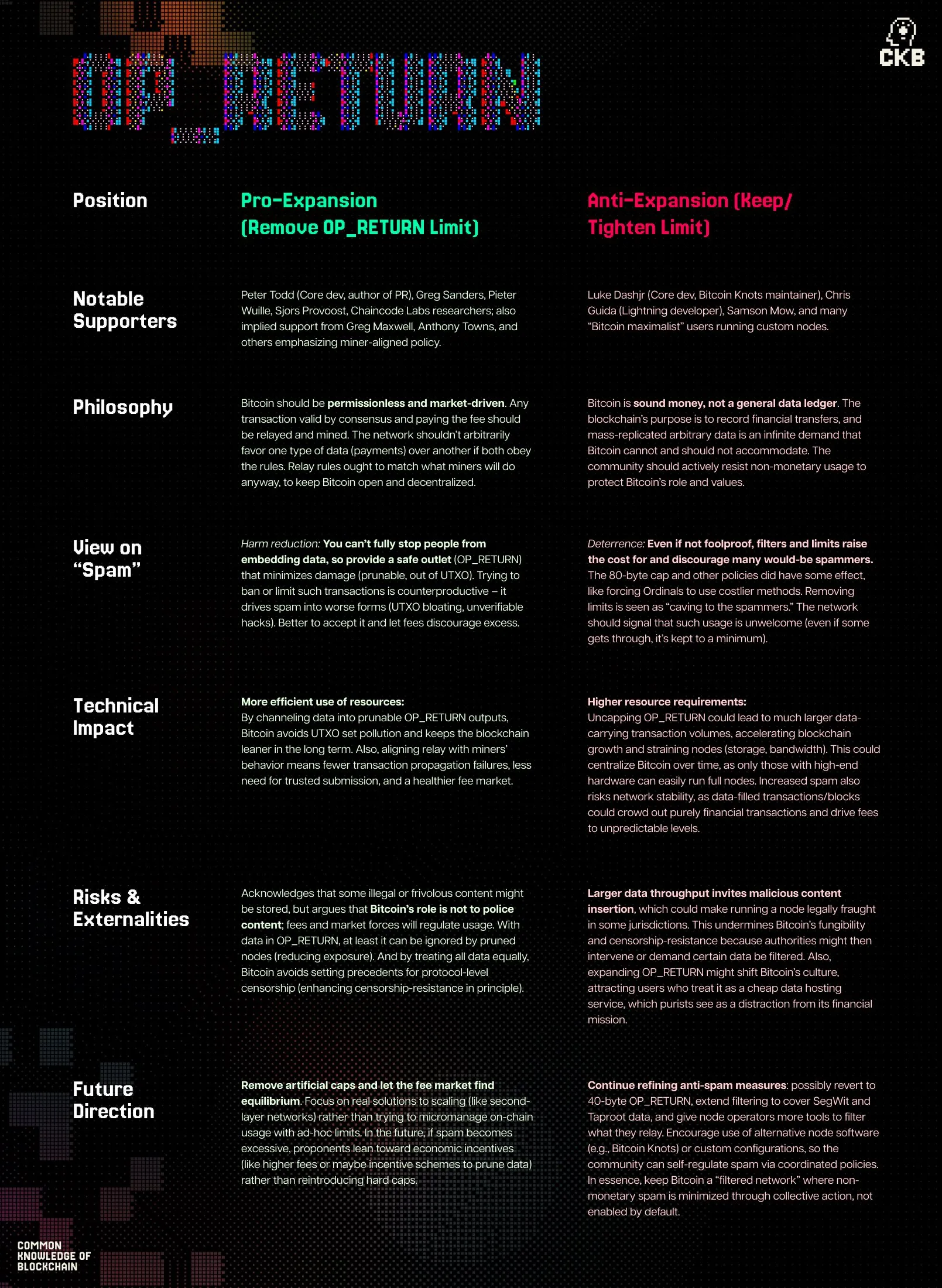-
Bitcoin Core’s upcoming v30 release will significantly increase the OP_RETURN data limit from 80 bytes to 4MB, sparking intense debates about Bitcoin’s scalability and decentralization.
-
This change has divided the community, with proponents highlighting enhanced infrastructure capabilities, while critics warn of potential blockchain bloat and centralization risks.
-
According to COINOTAG sources, the update has deepened ideological rifts, with some developers concerned about deviating from Bitcoin’s foundational principles.
Bitcoin Core v30’s OP_RETURN limit increase to 4MB ignites debates on scalability, decentralization, and trust within the Bitcoin community.
Bitcoin Core 30 Expands OP_RETURN Limit, Igniting Community Backlash
The Bitcoin Core development team has confirmed that version 30, scheduled for release in October 2025, will increase the OP_RETURN data limit from 80 bytes to nearly 4 megabytes. This represents a substantial expansion of Bitcoin’s on-chain data capacity, allowing for more extensive crypto inscriptions and data embedding directly on the blockchain.
Traditionally, OP_RETURN has been restricted to prevent blockchain bloat and maintain node decentralization. However, this update removes many of those constraints, aiming to support advanced Layer 2 solutions, decentralized identity frameworks, and BTC-anchored Web3 projects.
Despite these potential benefits, the change has reignited longstanding tensions within the Bitcoin community. Advocates for innovation see this as a necessary evolution, while purists emphasize the risks of increased UTXO bloat and the erosion of Bitcoin’s minimalistic design.
Bitcoin advocate Jimmy Song voiced strong opposition, highlighting the risk of increased on-chain spam and long-term sustainability issues:
OP_RETURN outputs greater than 83 bytes will increase significantly, UTXO bloat will keep getting worse and there will be more garbage on chain.
This is going to age like a bad tattoo. pic.twitter.com/hUTpg8a5NM
— Jimmy Song (송재준) (@jimmysong) June 9, 2025
Other community members expressed concerns about the potential centralization impact, noting a rise in alternative node implementations like Bitcoin Knots as a response to perceived unilateral decisions by Bitcoin Core developers.
“You ignore community consensus, you lose trust. Since Bitcoin Core’s OP_RETURN fiasco, Bitcoin Knots has surged from 2% to 11% of nodes. That’s what happens when contentious changes are rammed through,” one user commented.
Critics also accuse major development sponsors of pushing agendas that may undermine Bitcoin’s censorship resistance and decentralization ethos:
“Bitcoin Core™ (Chaincode/Spiral) just merged removal of the OP_RETURN filter to be released later this year in v30. This marks the end of ‘Bitcoin Core’ being the trusted reference client if it wasn’t already clear. It has been overtaken by shitcoin enablers,” another user posted.

Ideological divide between for OP_RETURN. Source: CKB on X
Victory for Reformists, but Critics Warn of Bloat, Centralization, and Trust Erosion
The push to expand OP_RETURN limits gained momentum following Peter Todd’s proposal in April 2025, which challenged the status quo and sparked debate over Bitcoin’s long-term trajectory.
Todd cautioned that increasing data capacity could accelerate centralization trends and compromise Bitcoin’s core values, yet acknowledged that current restrictions are often circumvented through forks and alternative clients.
“The restrictions are easily bypassed by direct substitution and forks of Bitcoin Core,” Todd noted in GitHub discussions, emphasizing that formalizing higher limits could legitimize existing practices and support emerging use cases like sidechains and cross-chain bridges.

Peter Todd’s proposal to remove arbitrary limits on OP_Return. Source: GitHub
Supporters argue that concerns about blockchain bloat and spam are overstated, suggesting that fee markets and filtering mechanisms can mitigate these risks while enabling Bitcoin to adapt to evolving technological demands.
They also contend that expanding OP_RETURN is essential for Bitcoin to maintain competitiveness in the broader cryptocurrency ecosystem, especially as programmable blockchain platforms continue to innovate.
This development follows closely on the heels of controversy surrounding Bitcoin Core’s recent transaction relay policy changes, which critics say favor well-connected nodes and reduce network accessibility.
Luke Dashjr, a prominent Bitcoin developer, criticized the relay changes, stating:
NACK
The goals of transaction relay listed are basically all wrong. Predicting what will be mined is a centralizing goal. Expecting spam to be mined is defeatism. Helping spam propagate is harmful.
This OPED contradicts itself, presenting out of band relay as both negative and…
— Luke Dashjr (@LukeDashjr) June 7, 2025
Despite the backlash, Bitcoin Core remains the dominant protocol implementation. However, the rising popularity of alternatives like Bitcoin Knots indicates a growing demand for clients that prioritize decentralization and adherence to Bitcoin’s original design philosophy.
With version 30 approaching, the Bitcoin community faces a critical juncture. The outcome of this debate will likely influence Bitcoin’s evolution as a programmable, multi-layered network and shape its role in the future digital economy.
Conclusion
The upcoming Bitcoin Core v30 release, with its substantial increase in OP_RETURN data capacity, highlights a pivotal moment in Bitcoin’s development. While the expansion promises enhanced functionality for Layer 2 and Web3 applications, it also raises valid concerns about blockchain bloat, centralization, and community trust. As ideological divisions deepen, the Bitcoin ecosystem must carefully balance innovation with the preservation of its foundational principles to ensure sustainable growth and decentralization. Stakeholders are encouraged to engage constructively in this ongoing dialogue to shape Bitcoin’s future responsibly.
